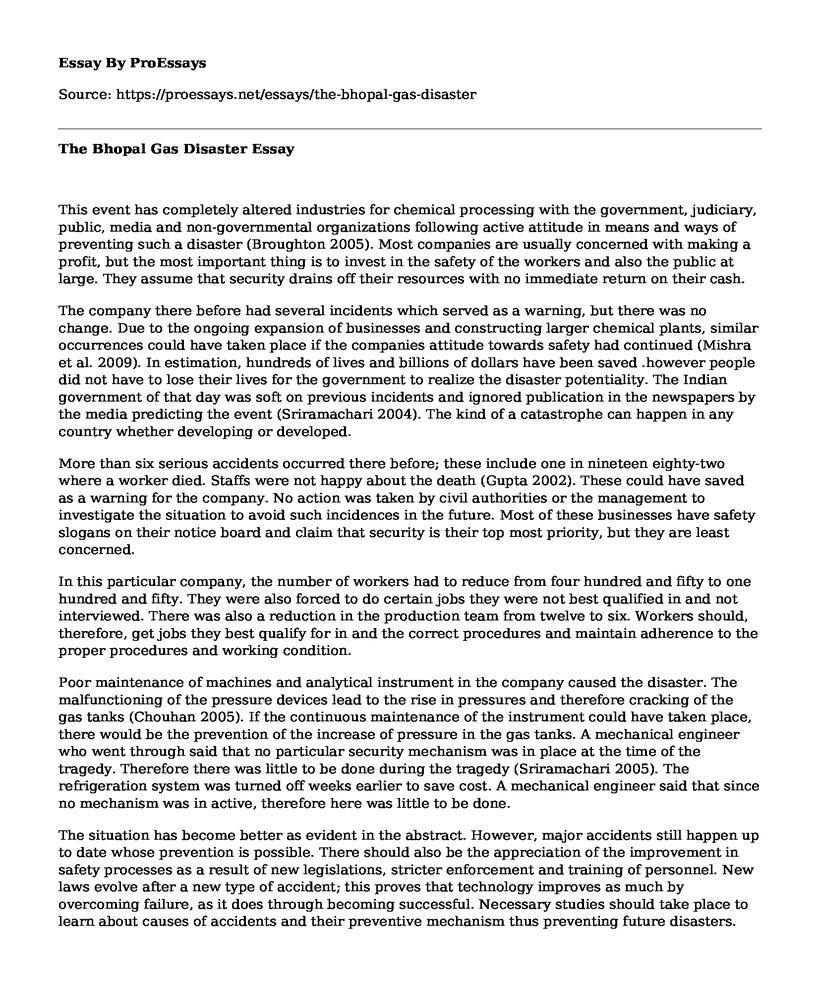This event has completely altered industries for chemical processing with the government, judiciary, public, media and non-governmental organizations following active attitude in means and ways of preventing such a disaster (Broughton 2005). Most companies are usually concerned with making a profit, but the most important thing is to invest in the safety of the workers and also the public at large. They assume that security drains off their resources with no immediate return on their cash.
The company there before had several incidents which served as a warning, but there was no change. Due to the ongoing expansion of businesses and constructing larger chemical plants, similar occurrences could have taken place if the companies attitude towards safety had continued (Mishra et al. 2009). In estimation, hundreds of lives and billions of dollars have been saved .however people did not have to lose their lives for the government to realize the disaster potentiality. The Indian government of that day was soft on previous incidents and ignored publication in the newspapers by the media predicting the event (Sriramachari 2004). The kind of a catastrophe can happen in any country whether developing or developed.
More than six serious accidents occurred there before; these include one in nineteen eighty-two where a worker died. Staffs were not happy about the death (Gupta 2002). These could have saved as a warning for the company. No action was taken by civil authorities or the management to investigate the situation to avoid such incidences in the future. Most of these businesses have safety slogans on their notice board and claim that security is their top most priority, but they are least concerned.
In this particular company, the number of workers had to reduce from four hundred and fifty to one hundred and fifty. They were also forced to do certain jobs they were not best qualified in and not interviewed. There was also a reduction in the production team from twelve to six. Workers should, therefore, get jobs they best qualify for in and the correct procedures and maintain adherence to the proper procedures and working condition.
Poor maintenance of machines and analytical instrument in the company caused the disaster. The malfunctioning of the pressure devices lead to the rise in pressures and therefore cracking of the gas tanks (Chouhan 2005). If the continuous maintenance of the instrument could have taken place, there would be the prevention of the increase of pressure in the gas tanks. A mechanical engineer who went through said that no particular security mechanism was in place at the time of the tragedy. Therefore there was little to be done during the tragedy (Sriramachari 2005). The refrigeration system was turned off weeks earlier to save cost. A mechanical engineer said that since no mechanism was in active, therefore here was little to be done.
The situation has become better as evident in the abstract. However, major accidents still happen up to date whose prevention is possible. There should also be the appreciation of the improvement in safety processes as a result of new legislations, stricter enforcement and training of personnel. New laws evolve after a new type of accident; this proves that technology improves as much by overcoming failure, as it does through becoming successful. Necessary studies should take place to learn about causes of accidents and their preventive mechanism thus preventing future disasters. Workers should also go through on-job-training on how to manage disasters in their workplace and the cause of action in case of a catastrophe. Companies should adhere to the laid down laws that govern their operations.
References
Chouhan, T.R., 2005. The unfolding of Bhopal disaster. Journal of loss prevention in the process industries, 18(4), pp.205-208.
Broughton, E., 2005. The Bhopal disaster and its aftermath: a review. Environmental Health, 4(1), p.1.
Gupta, J.P., 2002. The Bhopal gas tragedy: could it have happened in a developed country?. Journal of Loss Prevention in the process Industries, 15(1), pp.1-4.
Mishra, P., Samarth, R., Pathak, N., Jain, S., Banerjee, S. and Maudar, K., 2009. Bhopal gas tragedy: review of clinical and experimental findings after 25 years. International journal of occupational medicine and environmental health, 22(3), pp.193-202.
Sriramachari, S., 2005. Bhopal gas tragedy: Scientific challenges and lessons for future. Journal of loss prevention in the process industries, 18(4), pp.264-267.
Sriramachari, S., 2004. The Bhopal gas tragedy: An environmental disaster. Current Science, 86(7), pp.905-920
Cite this page
The Bhopal Gas Disaster. (2021, Mar 04). Retrieved from https://proessays.net/essays/the-bhopal-gas-disaster
If you are the original author of this essay and no longer wish to have it published on the ProEssays website, please click below to request its removal:
- Positive and Negative Aspects of Using Crude Oil in Running Cars - Research Paper
- Research Paper on Dealing With Climate Changes and Global Warming
- Argumentative Essay Sample on Climate Change
- Is Blockchain Living Up to the Hype? - Article Analysis Essay
- Essay on Lack of Diversity and Inclusion at Yelp: Impacts on Performance and Market Share
- Essay Sample on Global Expansion: Research & Considerations Before Taking the Plunge
- Free Trade: Removing Barriers to Encourage Trade - Essay Sample







